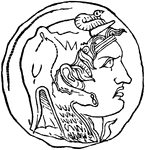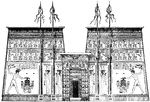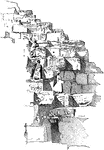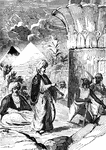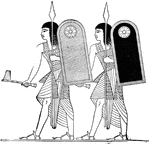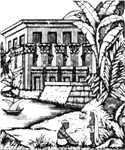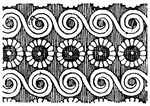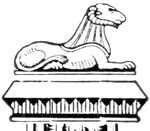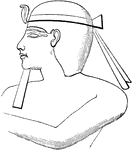
Ptolemy in Profile
He was a mathematician, geographer, astronomer, and astrologer. "The name of a line Graeco-Egyptain…
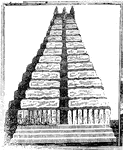
Ancient Pyramid
"The pyramids of Egypt are well entitled to a place among the most interesting curiosities in the world.…

Ramesses II Returning From Syria
An illustration of an Egyptian hieroglyphic depicting Ramesses II returning in triumph from Syria.

Ramses II in Profile
"Ramses II was a powerful sovereign, called Sesostris by the Greeks, identified by many with the Pharaoh…
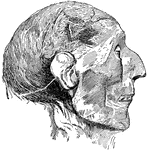
Head of Mummy of Ramses II
"The mummy was discovered in 1881, in an underground chamber near the site of Thebes. With it were the…

Ramses the Great
Also known as Ramses II. A profile portrait of Ramses the Great with carvings behind his head. He is…
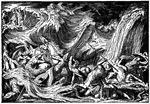
The Red Sea Swallows Pharaoh and His Army
"And Moses stretched forth his hand over the sea, and the sea returned to its strength when the morning…

Egyptian Rope Making
"Reproduction of sculpture from a tomb in Thebes, showing preparation of leather cords by process similar…
Rosetta Stone
"In 1799, the Rosetta Stone was found and gave the first key to the reading of hieroglyphics. On this…
Excerpt from the Rosetta Stone
"In 1799, the Rosetta Stone was found and gave the first key to the reading of hieroglyphics. On this…

Rosetta Stone Sample
"In 1799, the Rosetta Stone was found and gave the first key to the reading of hieroglyphics. On this…
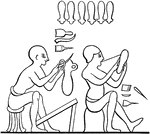
Egyptian Sandal Makers
"The Ancient Sandal Maker as pictured on the wall of the ruined temples at Thebes, Egypt." -Bodmer,…

Sargon's Palace at Khorsabad
An illustration of the restoration of a court in Sargon's palace at Khorsabad.
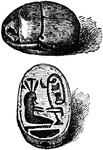
Scarab
The scarab is a carved piece of stone used as an amulet that represents a scarab beetle on one side…
Scarab
"Scarab, a conventional beetle, which is a common motive in Egyptian art. The more oval form here seen…
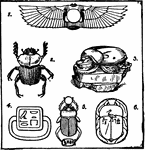
Egyptian scarabs
The ancient Egyptians regarded the scarab as a symbol of immortality. 1. Stone scarab with wings, 2.…
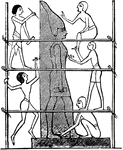
Egyptian Sculptors at Work
"Workmen are represented polishing and painting statues of men, sphinxes, and small figures; and two…

Serapis
"Serapis or Hermes is sometimes represented as identical with Osiris, and sometimes as a distinct divinity,…
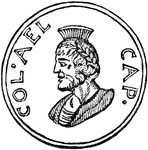
Serapis
The portrait of Serapis, a deity in Egypt, who was also thought to be brought to Jerusalem and worshiped…
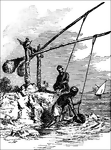
Shadoofs, Two Men Raising Water
"A contrivance extensively employed in Egypt and the East, generally for raising water. It consists…
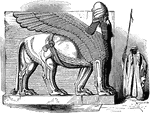
Shedu
The Shedu is a celestial being from Mesopotamian mythology. He is a human above the waist and a bull…

The Sheikh-El-Beled
"Supposed portrait of one of the overseers of the work on the Great Pyramid. This is one of the masterpieces…

Egyptian Shop
"The Egyptian shops exhibited many curious scenes. Poulters suspended geese and other birds from a pole…

Siege of a City with Battering Ram
An illustration of a hieroglyphic depicting the siege of a city showing the use of a battering ram.
Sowing
"Egyptian Sowing. The people were mainly agricultural, but employed rude methods of cultivation. In…

Sphinx
"Sphinx is a Greek word signifying 'strangler,' applied to certain symbolical forms of Egyptian origin,…
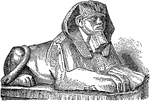
Sphinx
A Sphinx is a zoomorphic mythological figure which is depicted as a recumbent lion with a human head.

The Great Sphinx
"This colossal figure, human-headed and lion-bodied, is hewn from the natural rock. The body is about…
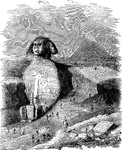
The Great Sphinx at Giza
A statue built on the Giza Plateau in Giza, Egypt, consisting of a lion with a human head. The Sphinx…
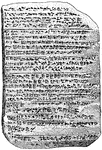
The Amarna Tablet
A series of correspondence on clay tablets between the Egyptian administration and its representatives…

Battle of Tel al-kebir
The Battle of Tel-el-Kebir happened on September 13, 1882 in the Suez Canal area of Egypt, between the…
Column from the Temple of Denderah, with Hathor Masks, Time of Cesar
Column located in the Temple of Denderah, with masks of Hathor, an Egyptian sky goddess of love and…
